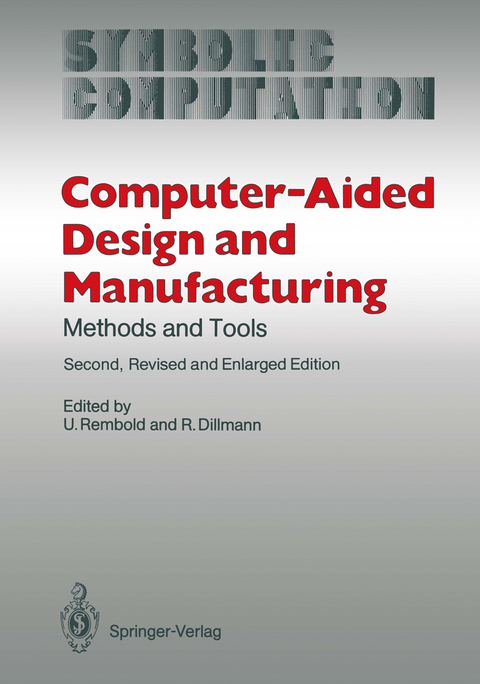
Computer-Aided Design and Manufacturing
Springer Berlin (Verlag)
978-3-642-82750-1 (ISBN)
1 CAD Systems and Their Interface with CAM.- 1.1 Introduction.- 1.2 Philosophy of the Application of CAD Systems.- 1.3 Software Structure of CAD Systems.- 1.4 Computer Internal Model.- 1.5 Interfaces of CAD Systems.- 1.6 Integration of the Manufacture Planning Process.- 1.7 Economic Aspects.- 1.8 Conclusion.- 1.9 References.- 1.10 Additional Literature.- 2 Design for Assembly.- 2.1 Introduction.- 2.2 Design for Assembly Philosophy.- 2.3 Determination of the Most Appropriate Process.- 2.4 Re-design for Manual Assembly.- 2.5 Re-design for Automatic Assembly.- 2.6 Robots in Manufacturing.- 2.7 Characteristics of Assembly Robots.- 2.8 Requirements for Robotic Assembly.- 2.9 Classification and Coding for Automatic Parts Handling for Flexible Assembly.- 2.10 Classification and Coding for Automatic Insertion for Flexible Assembly.- 2.11 Conclusions.- 3 Technological Planning for Manufacture - Methodology of Process Planning.- 3.1 Methodology of Process Planning.- 3.2 Development of APT and EXAPT.- 3.3 Techniques of Computer Aided Process Planning.- 3.4 Graphical Simulation of Manufacturing Processes in Process Planning.- 3.5 Systems for Computer Aided Process Planning Including Quality Control.- 3.6 The CAPSY Process Planning System.- 3.7 Planning of Assembly Sequences.- 3.8 N/C Technology.- 3.9 N/C Programming on the Shop Floor Using Graphical Simulation Techniques.- 3.10 Programming of Robots Using Graphical Techniques.- 3.11 Integrated Aspects of Technological Planning.- 3.12 References.- 4 Evolutionary Trends in Generative Process Planning.- 4.1 Introduction.- 4.2 The Principal CAPP Methodologies.- 4.3 Generative Process Planning.- 4.4 Adequacy of the Existing GPP's in the Wake of New Developments.- 4.5 Dynamic GPP Using Pattern Recognition Techniques: A New Concept.-4.6 References.- 5 Design Methodology of Computer Integrated Manufacturing and Control of Manufacturing Units.- 5.1 Introduction.- 5.2 The Need for a Methodology and a Conceptual Model of a CIM System.- 5.3 Conceptual Model of a CIM System.- 5.4 Methods of Designing Production Control Systems.- 5.5 Design of Flexible Manufacturing Systems Using Modelling Techniques and Simulation.- 5.6 The Control of the Manufacturing Unit.- 5.7 GRAI's Approach to Manufacturing Control.- 6 Computing Aids to Plan and Control Manufacturing.- 6.1 Hierarchical Computer Control Equipment for Manufacturing Systems.- 6.2 Hierarchical Control Architecture for Manufacturing Cells.- 6.3 Graphical Simulation Techniques for Planning and Programming of Robot Based Manufacturing Cells.- 6.4 Advanced Computer Architectures (5th Generation).- 6.5 References.- 7 Programming of Robot Systems.- 7.1 Robot Languages in the Eighties.- 7.2 Programming Languages for Manipulation and Vision in Industrial Robots.- 7.3 Programming a Vision System.- 7.4 Towards Automatic Error Recovery in Robot Programs.- 7.5 References.- 8 Present State and Future Trends in the Development of Programming Languages for Manufacturing.- 8.1 Introduction.- 8.2 Programming of Machine Tools.- 8.3 Programming Languages for Robots.- 8.4 Process Control.- 8.5 Commercial Data Processing.- 8.6 Future Trends.- 8.7 References.- 9 Quality Assurance and Machine Vision for Inspection.- 9.1 Introduction.- 9.2 Quality Assurance: Functions, Problems and Realizations.- 9.3 Machine Vision: Inspection Techniques, Mensuration and Robotics.- 9.4 References.- 10 Production Control and Information Systems.- 10.1 Strategies for the Selection of Software Packages in Production.- 10.2 Data Management Requirements for Production Control.- 10.3 PlanningStrategies for the Implementation of Production Control Systems.- 10.4 The Interface Between CAD and Production Control.- 10.5 The Interface Between Production Control and Marketing.- 10.6 Factors Influencing the Acceptance of Production Control Software.- 11 Economic Analysis of Computer Integrated Manufacturing Systems.- 11.1 Introduction.- 11.2 Process Planning.- 11.3 Capacity Analysis Using CAN-Q.- 11.4 Capital and Labour Requirements.- 11.5 Payback, Capital Cost, and Taxes.- 11.6 Cost Comparisons.- 11.7 System Efficiency.- 11.8 Justification and Automation Equipment.- 11.9 Summary.- 11.10 References.- 11.11 Appendix.- Contributors.
| Erscheint lt. Verlag | 8.12.2011 |
|---|---|
| Reihe/Serie | Computer Graphics - Systems and Applications | Symbolic Computation |
| Zusatzinfo | XIV, 458 p. |
| Verlagsort | Berlin |
| Sprache | englisch |
| Maße | 170 x 244 mm |
| Gewicht | 813 g |
| Themenwelt | Informatik ► Weitere Themen ► CAD-Programme |
| Schlagworte | Automation • Complexity • Computer-Aided Design (CAD) • Model |
| ISBN-10 | 3-642-82750-0 / 3642827500 |
| ISBN-13 | 978-3-642-82750-1 / 9783642827501 |
| Zustand | Neuware |
| Informationen gemäß Produktsicherheitsverordnung (GPSR) | |
| Haben Sie eine Frage zum Produkt? |
aus dem Bereich


